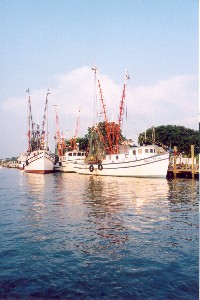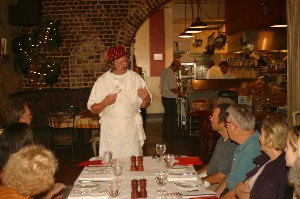Special Feature: Products Sally Recommends
Hooked on Shad
Without the fortuitous advent of the shad, the outcome of the American Revolution might have been quite different. But, more about this later. I never put much stock in whether the groundhog sees his shadow. There are more reliable signs. When daffodils start to show their buttery little faces around town, I know that spring is on its way. Most people easily recognize these Lowcountry favorites, but few may know another spring bloomer – the shadbush. Its snowy white flowers signal not only the arrival of spring but also announce the annual shad migration. Native Americans along our East Coast Rivers knew that when the shadbush (also known as Serviceberry, or Juneberry) bloomed, the annual spring shad migration was underway.
The American Shad, largest member of the herring family, Alosa Sapidissima, is a beauty of a fish. With glittering lavender tails and metallic blue-green backs that fade into silver along their sides, a school of these shimmering, sleek fish thrill even the most experienced angler. Shad are anadromous, meaning they migrate from their saltwater habitat to spawn in fresh water. They spend most of their lives in the ocean before returning to the rivers of their birth to reproduce and die. Shad are usually between four and six years old when they leave the ocean to swim back to their home rivers. During a short season in spring, any time between February and July depending on the region and the weather, they will leave the ocean in the hundreds of thousands and run up rivers – sometimes going heroic distances – to spawn. During an average lifespan of five years, a single fish may travel as many as 12,000 miles. Shad prefer water temperatures between 55 and 61 degrees Fahrenheit, so migration occurs earlier in the warmer southern waters and later in northern waters. Peak season in South Carolina occurs in February and March.
 The Native Americans fished for shad and taught the colonists their methods. They used the fish for fertilizer as well as eating both it and the roe. Shad were relatively easy to catch, were tasty and nutritious, and could be salted for use during the winter months. In Colonial times, waters up and down the Atlantic Coast teemed with shad and herring. John McPhee, author of The Founding Fish, writes that George Washington engaged in commercial shad fishing and in 1771, reported a catch of 7,760. Some believe that the spring migration of great schools of shad up the Schuylkill River in 1778 saved George Washington’s troops from starvation at Valley Forge and that without the fortuitous advent of the shad, the outcome of the American Revolution might have been quite different. Reason enough to put this fish in the historical hall of fame.
The Native Americans fished for shad and taught the colonists their methods. They used the fish for fertilizer as well as eating both it and the roe. Shad were relatively easy to catch, were tasty and nutritious, and could be salted for use during the winter months. In Colonial times, waters up and down the Atlantic Coast teemed with shad and herring. John McPhee, author of The Founding Fish, writes that George Washington engaged in commercial shad fishing and in 1771, reported a catch of 7,760. Some believe that the spring migration of great schools of shad up the Schuylkill River in 1778 saved George Washington’s troops from starvation at Valley Forge and that without the fortuitous advent of the shad, the outcome of the American Revolution might have been quite different. Reason enough to put this fish in the historical hall of fame.
Despite its relatively short season of about three months, shad fishing was a major part of the economy and culture of the Atlantic Coast. Many businesses flourished because of the industry, creating jobs for net makers, boat makers, carpenters, wagoners, and peddlers. Over a hundred years ago along the Susquehanna River, the fish peddler announced fresh shad for sale with a loud shout – Shad-o-e! – accompanied by a loud blast from his brass horn. Local newspapers printed announcements that shad had arrived and warned readers “not to be fooled into buying day-old fish of poor quality. ” Since the beginning of the 1900’s, dam building, pollution, and excessive harvesting have contributed to the decline of shad populations. Thankfully, restoration efforts are bringing back this important fish. Today, Virginia leads in coastal commercial shad fishing, followed by Delaware, New Jersey and South Carolina. South Carolina’s commercial shad fishery produces approximately half a million pounds annually.
Shad is a fish that has known its ups and downs with consumers. It has been called “the poor man’s salmon” and, on occasion, mentioned in the same breath with carp and mullet. Today, however, thanks to local chefs and food enthusiasts, shad and shad roe are regaining their popularity. A plate of steaming hot grits topped with shad roe and bacon can convince even the most skeptic. The rich, slightly sweet nutty flavor of the roe perfectly complements one of our favorite grains. The fish itself has moderately firm, beige colored flesh that is distinctively rich and delicious. Alosa Sapidissima in fact means “ most delicious”. One drawback – they have hundreds of bones. An Indian legend sheds light on the bony nature of this fish. According to the legend, “There once was a porcupine that was unhappy with its place in the world, so he asked the Great Spirit Manitou to give him a better situation in life. Happy to please, the Great Spirit turned him inside out and threw him into the river.” Fortunately, you can buy the fish already filleted.
With so much of our food traveling thousands of miles to get to our tables, buying local fish – fresh off the boat – is a real treat. Not only do we get fresher and tastier food, we also support our local fishing industry. In turn, local fishermen spend their earnings in our community where those dollars recirculate many times before leaving the area. Shop for shad at local markets or, better yet, pack a lunch and head to the Santee to catch your own.
Recipe
Shad Croquettes

Chef Frank Lee, Slightly North of Broad restaurant in Charleston, shared this recipe. Chef Lee is an avid supporter of local products and features them creatively on his menus. When March arrives, my husband and I will head to Slightly North of Broad in search of one of Chef Lee’s fabulous shad or shad roe dishes.
The Croquettes
1 pound skinned Shad (can use deboned fillets)
1 tsp salt
1 tsp white pepper
1 egg
2 large shallots, minced
½ c. fresh chives, thinly cut
½ c. fresh parsley, chopped
½ c. fresh tarragon, chopped
2 tbsp sour cream
2 tbsp fresh lemon juice
½ c. panko breadcrumbs
Take the first 3 ingredients and pulse in a food processor. Add egg and pulse again. Place mixture in stainless steel bowl, and add all remaining ingredients. Mix well.
Form into 3-oz. patties, and then roll in additional panko (breadcrumbs used in Japanese cooking for coating fried foods). Sauté in butter until golden and firm.
Serve with salad and a tart dressing of your choice. Add tartar sauce on the side.
Shad (Planked)
This method of cooking shad, laying it out on a plank and roasting it over hot coals, is often attributed to Native American tribes who inhabited the East Coast. Many versions of this recipe are found in early cookbooks, including the Carolina Housewife. This recipe is from Charleston Receipts, published in 1950.
Scale and clean a 4-5 pound shad, preferably a roe shad (the female). Remove head and fins and with a very sharp knife cut along backbone on either side, making two fillets. Backbone portions with flesh adhering may be reserved for frying. Salt and pepper fillets. Grease well a large oak plank about 18 inches long (can be purchased in hardware stores) and place fillets skin side down on plank. Dot fish with butter and broil under medium flame until done (20-30 minutes). When done, fish flakes easily when touched with fork. Add more butter just before removing from oven. Finely chopped parsley may be sprinkled over fish or parsley springs with lemon slices used as garnish. The roe may be broiled separately and added to the plank if desired. Serve with sauce tartare. Serves 6, generously.
![]()
Amanda Dew Manning, a Food and Society Policy Fellow, is a 10 th generation South Carolinian andPresident of Carolina FoodPros™ specializing in South Carolina Culinary Traditions gift boxes, exclusive culinary tours and seminars. She can be reached at (843) 723-3366 or online at www.carolinafoodpros.com.
Note: This information was accurate when it was published. Please be sure to confirm all rates and details directly with the businesses in question before making your plans.



